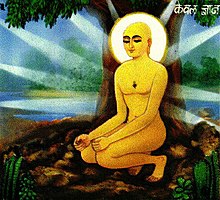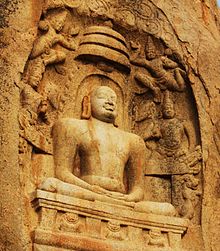This article is about the term in Jainism. For the term Arhat or Arahant in Buddhism, see Arhat.
| Part of a series on |
| Jainism |
|---|
 |
| Philosophy |
EthicsEthics of Jainism
|
| Jain prayers |
| Major figures |
| Major sectsSchools and Branches |
| Jain literature |
| Festivals |
| PilgrimagesTirth |
| Other |

Arihant (Jain Prakrit: अरिहन्त, Sanskrit: अर्हत् arhat, lit. 'conqueror') is a jiva (soul) who has conquered inner passions such as attachment, anger, pride and greed. Having destroyed four inimical karmas, they realize pure self. Arihants are also called kevalins (omniscient beings) as they possess kevala jnana (pure infinite knowledge). An arihant is also called a jina ("victor"). At the end of their life, arihants destroy remaining karmas and attain moksha (liberation) and become siddhas. Arihantas have a body while siddhas are bodiless pure spirit. The Ṇamōkāra mantra, the fundamental prayer dedicated to Pañca-Parameṣṭhi (five supreme beings), begins with Ṇamō arihantāṇaṁ, "obeisance to the arihants".
Kevalins - omniscient beings - are said to be of two kinds
- Tirthankara kevalī: 24 human spiritual guides who after attaining omniscience teach the path to salvation.
- Sāmānya kevalī: Kevalins who are concerned with their own liberation.
According to Jains, every soul has the potential to become an arihant. A soul which destroys all kashayas or inner enemies like anger, ego, deception, and greed, responsible for the perpetuation of ignorance, becomes an arihant.
Philosophy
Main article: Jain philosophyAccording to Jain texts, omniscience is attained on the destruction of four types of karmas– deluding, the knowledge-obscuring, the perception-obscuring and the obstructive karmas, in the order mentioned. The arihants are said to be free from the following eighteen imperfections:
- janma – (re)birth
- jarā – old-age
- triśā – thirst
- kśudhā – hunger
- vismaya – astonishment
- arati – displeasure
- kheda – regret
- roga – sickness
- śoka – grief
- mada – pride
- moha – delusion
- bhaya – fear
- nidrā – sleep
- cintā – anxiety
- sveda – perspiration
- rāga – attachment
- dveśa – aversion
- maraņa – death
Omniscience
Main article: Kevala jnana
In Jainism, omniscience is said to be the infinite, all-embracing knowledge that reflects, as it were in a mirror, all substances and their infinite modes, extending through the past, the present and the future. According to Jain texts, omniscience is the natural attribute of the pure souls. The self-attaining omniscience becomes a kevalin. Pandit Banarasidas in Samaysaar Natak describes the Omniscient soul as:
जोग धरै रहै जोगसौं भिन्न,
अनंत गुनातम केवलज्ञानी । तासु हृदै-द्रहसौं निकसी, सरितासम है श्रुत-सिंधु समानी ।। याते अनंत नयातम लच्छन, सत्य स्वरूप सिधंत बखानी । बुद्ध लखै न लखै दुरबुद्ध,
सदा जगमाँहि जगै जिनवानी ।।३।।
Meaning: The omniscient Lord has perfect complete knowledge. He does have physical form but has separated self from the material body. From His heart-type of lake, a river has come out in the form of spiritual preachings and has merged into the ocean of holy scriptures. Therefore, such doctrines are called ultimate truth, encompassing infinite partial points of views. The aspirant souls end up recognising such principles. The foolish wrong faithed persons fail to identify such truth. May such Omniscient knowledge of Arihants be victorious in the universe!
The four infinitudes (ananta cātuṣṭaya) are:
- ananta jñāna, infinite knowledge
- ananta darśana, perfect perception due to the destruction of all darśanāvaraṇīya karmas
- ananta sukha, infinite bliss
- ananta vīrya – infinite energy
Tirthankaras
Main article: Tirthankara
Those arihants who re-establish the Jain faith are called tirthankaras. Tirthankaras revitalize the sangha, the fourfold order consisting of male saints (sādhus), female saints (sādhvis), male householders (śrāvaka) and female householders (srāvika).
The first tirthankara of the current time cycle was Ṛṣabhanātha, and the twenty-fourth and last Tirthankara was Mahavira, who lived from 599 BCE to 527 BCE.

Jain texts mention forty-six attributes of arihants or tirthankaras. These attributes comprise four infinitudes (ananta chatushtaya), thirty-four miraculous happenings (atiśaya), and eight splendours (prātihārya).
The eight splendours (prātihārya) are:
- aśokavrikśa – the Ashoka tree
- siṃhāsana– bejeweled throne
- chatra – three-tier canopy
- bhāmadal – halo of unmatched luminance
- divya dhvani – divine voice of the Lord without lip movement
- puśpavarśā – shower of fragrant flowers
- camara – waving of sixty-four majestic hand-fans
- dundubhi – dulcet sound of kettle-drums and other musical instruments
Liberation
At the time of nirvana (final release), the arihant sheds off the remaining four aghati karmas:
- Nama (physical structure forming) karma
- Gotra (status forming) karma
- Vedniya (pain and pleasure causing) karma
- Ayushya (life span determining) karma
These four karmas do not affect the true nature of the soul and are therefore called aghati karmas.
Worship

In the Ṇamōkāra mantra, Namo Arihantanam, Namo Siddhanam, Jains worship the arihants first and then to the siddhas, even though the latter are perfected souls who have destroyed all karmas but arihants are considered to be at a higher spiritual stage than siddhas. Since siddhas have attained ultimate liberation, they probably are not directly accessible but may be through the wisdom they passed on. However arihants are accessible for spiritual guidance of human society until their nirvana. The Dravyasaṃgraha, a major Jain text, states:
Having destroyed the four inimical varieties of karmas (ghātiyā karmas), possessed of infinite faith, happiness, knowledge and power, and housed in most auspicious body (paramaudārika śarīra), that pure soul of the World Teacher (Arihant) should be meditated on.
— Dravyasaṃgraha (50)
See also
Notes
- ^ Sangave 2001, p. 15.
- ^ Sangave 2001, p. 16.
- Sangave 2001, p. 164.
- Rankin 2013, p. 40.
- Jain, S.A. (1960). Reality. Vira Sasana Sangha. p. 282.
Non-Copyright
- ^ Jain 2014, p. 3.
- Jain 2014, p. 2.
- Banarasi Das. Samaysaar Natak.
- Jain 2013, p. 181.
- Jain 2013, p. 177.
References
- Jain, Vijay K. (2013). Ācārya Nemichandra's Dravyasaṃgraha. Vikalp Printers. ISBN 9788190363952.
Non-copyright
- Jain, Vijay K. (26 March 2014), Acarya Pujyapada's Istopadesa – the Golden Discourse, Vikalp Printers, ISBN 9788190363969
- Rankin, Aidan (2013), "Chapter 1. Jains Jainism and Jainness", Living Jainism: An Ethical Science, John Hunt Publishing, ISBN 978-1780999111
- Sangave, Vilas Adinath (2001), Aspects of Jaina religion (3 ed.), Bharatiya Jnanpith, ISBN 81-263-0626-2
External links
![]() Quotations related to Arihant (Jainism) at Wikiquote
Quotations related to Arihant (Jainism) at Wikiquote
| Gods | |||||
|---|---|---|---|---|---|
| Philosophy | |||||
| Branches |
| ||||
| Practices | |||||
| Literature | |||||
| Symbols | |||||
| Ascetics | |||||
| Scholars | |||||
| Community | |||||
| Jainism in |
| ||||
| Jainism and | |||||
| Dynasties and empires | |||||
| Related | |||||
| Lists | |||||
| Navboxes | |||||